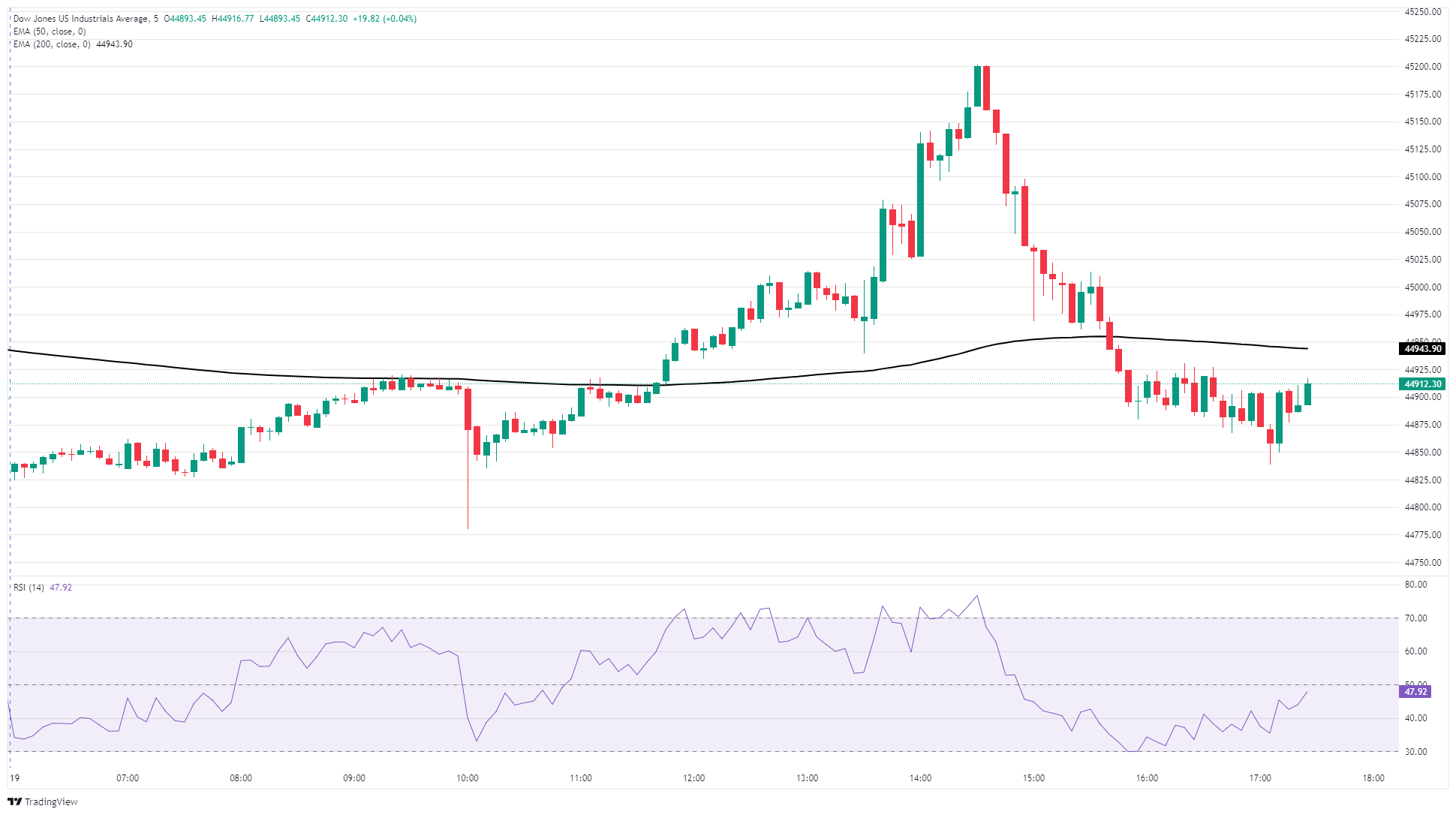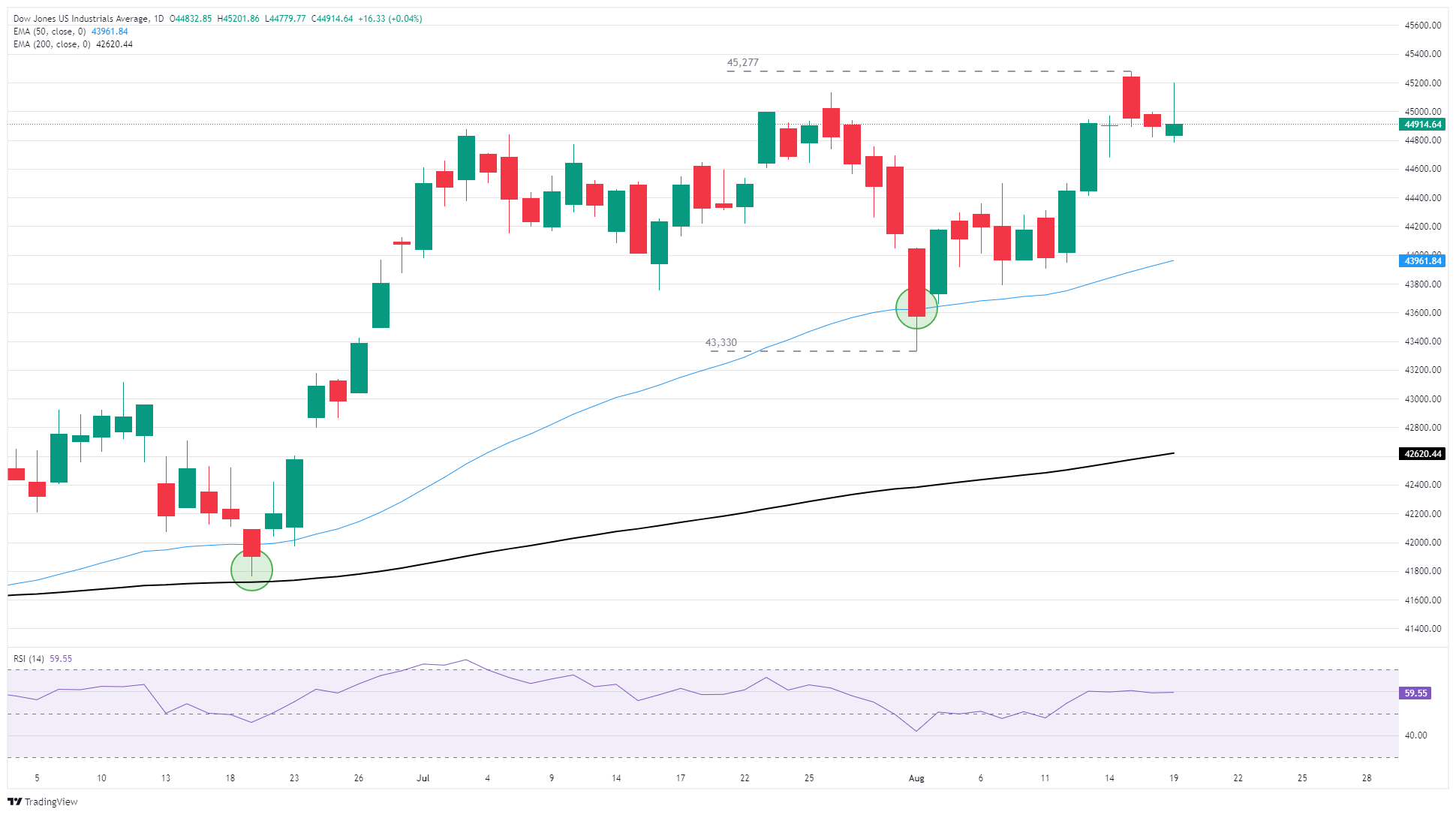Dow Jones Industrial Average grapples with fizzling tech rally
- The Dow Jones backslid again on Tuesday as equities waffle on tech outlook.
- Key earnings reports point to a cooldown in US consumer habits.
- Central bank policy statements and PMI survey results loom large over the rest of the week.
The Dow Jones Industrial Average (DJIA) flubbed an early rise on Tuesday, jumping higher before backsliding through the rest of the day, erasing the early morning gains. Investors are reconsidering their overly bullish positions heading into the midweek, trimming their exposure to the ongoing AI-fueled tech rally and hesitating after mega-sized home building supplier Home Depot (HD) missed earnings growth expectations.
The Dow Jones is still grappling with the 45,000 handle as major names on the Dow take a knee on Tuesday, balancing out gains made on the other side of the stock index. 45,277 remains the level to beat for buyers to push the Dow Jones back into fresh record highs, but the major equity index could be poised for a further pullback with price action testing well north of the 50-day Exponential Moving Average (EMA) near 43,875.
Key building supplier gains ground, but red flags are surfacing
Home building supplier Home Depot showed ongoing earnings growth in the second quarter, with revenue reaching $45.38B for the single quarter, and up around 5% YoY. However, Home Depot earnings still missed analyst expectations for the second quarter in a row. Home Depot stock gained firm ground on Tuesday, up around 3% on the day at the time of writing, but missed expectations are giving investors cause for pause on their assumptions about ongoing earnings growth. Consumers are beginning to revamp their home building and renovation habits, pivoting away from major projects and opting for smaller, cheaper projects, leaving big-ticket supplies and items on the shelves in favor of an increase in small-scale home investments and appliances.
Just as recession-wary consumers are switching to investing in appliances and cheaper home improvements rather than investing in large-scale renovations and upgrades, early tariff effects are already leaking through supply chains. Supply chain length and complexity, rather than earth-shattering bartering power, is sparing US consumers from the brunt of tariff-led price changes. Prices are rising faster and sooner in categories with shorter, more efficient supply chains, specifically in items such as appliances and small-scale home improvements. With consumers pivoting away from large home improvements in favor of medium-ticket items, the door could be closing on a major economic engine of US consumption.
Tech rally takes a rare double-glance
The AI tech craze caught a rare moment of clarity on Tuesday as the landscape continues to shift beneath the feet of ChatGPT-prompting navel-gazers. Tech stocks saw unexpected declines on the day, with AI flagship Nvidia (NVDA) backsliding over 3%. Facebook parent company Meta (META) announced it would be “restructuring” its entire AI division into smaller core groups with more defined design targets. This will pull a large portion of Meta’s AI development focus away from aiming for hypothetically profitable AI product offerings and refocus on ambiguously profitable “superintelligence” projects. Meta has also announced its departure from using strictly in-house tech to further its AI research goals and will now be accessing third-party technology from other AI companies. These are ostensibly the same AI research farms that Meta has spent the past two years hollowing out through billion-dollar talent-poaching schemes.
Dow Jones 5-minute chart

Dow Jones daily chart

Dow Jones FAQs
The Dow Jones Industrial Average, one of the oldest stock market indices in the world, is compiled of the 30 most traded stocks in the US. The index is price-weighted rather than weighted by capitalization. It is calculated by summing the prices of the constituent stocks and dividing them by a factor, currently 0.152. The index was founded by Charles Dow, who also founded the Wall Street Journal. In later years it has been criticized for not being broadly representative enough because it only tracks 30 conglomerates, unlike broader indices such as the S&P 500.
Many different factors drive the Dow Jones Industrial Average (DJIA). The aggregate performance of the component companies revealed in quarterly company earnings reports is the main one. US and global macroeconomic data also contributes as it impacts on investor sentiment. The level of interest rates, set by the Federal Reserve (Fed), also influences the DJIA as it affects the cost of credit, on which many corporations are heavily reliant. Therefore, inflation can be a major driver as well as other metrics which impact the Fed decisions.
Dow Theory is a method for identifying the primary trend of the stock market developed by Charles Dow. A key step is to compare the direction of the Dow Jones Industrial Average (DJIA) and the Dow Jones Transportation Average (DJTA) and only follow trends where both are moving in the same direction. Volume is a confirmatory criteria. The theory uses elements of peak and trough analysis. Dow’s theory posits three trend phases: accumulation, when smart money starts buying or selling; public participation, when the wider public joins in; and distribution, when the smart money exits.
There are a number of ways to trade the DJIA. One is to use ETFs which allow investors to trade the DJIA as a single security, rather than having to buy shares in all 30 constituent companies. A leading example is the SPDR Dow Jones Industrial Average ETF (DIA). DJIA futures contracts enable traders to speculate on the future value of the index and Options provide the right, but not the obligation, to buy or sell the index at a predetermined price in the future. Mutual funds enable investors to buy a share of a diversified portfolio of DJIA stocks thus providing exposure to the overall index.

